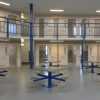
My in-box today had several messages of interest about Covid-19.
Item 1: Tim Hortons wants us to know the seating areas in all their restaurants are now closed. The coffee shop will be serving the drive-through crowd and the folks who want take-out snacks.
Both are a problem for the employees. Timmie’s staff who lean out the window to serve coffee at the drive-through are less than 18 inches from the driver of any vehicle. At the counter, workers are about a foot from anyone they serve at the cash register.
In my Timmies, the walk-in customers line up during the morning commute and at mid-morning break time. Most customers stand less than 12 inches from the one ahead of them in line—or behind them.
Item 2: The CEO of Staples Canada wants us to know that what he calls “The Working and Learning Company” will continue to provide excellent service, and office supplies including wipes, sanitizers and other cleaning products.
The Canadian CEO says, “We have reinforced hygiene protocols, restricted business travel for our associates and paused in-store events … We’ve also taken numerous precautions to keep our stores, associates and customers safe, including increased cleaning at every location.”
What about the cleaners, the employees who are usually paid the least, and the clerks or sales “associates” who earn perhaps a dollar or two more than minimum wage. Minimum wage in Nova Scotia is $11.55 an hour; next month it increases to $12.55 – a far cry from the suggested Living Wage of about $19.00/hour. That is the real cost to live in dignity in Halifax and much of the province.
Store hours will remain long. And no amount of cleaning and sanitizing is going to help with the social distancing needed to stop the scary trajectory of Covid-19 virus.
Item 3: The top brass at Saint Mary’s University wants us to know that lectures and public events are cancelled for this week, and the next two weeks. International students and those whose homes are elsewhere are encouraged to go home.
Of course the Canadian government is all but demanding people do not travel. And foreign students who try to return may not be allowed back in Canada while the virus is raging. Students can still remain in residence rooms, but the cafeteria and other services have been cut back dramatically.
The professors are permitted to stay at home, and teach online. But the staff including the cleaners, the cafeteria staff, the library and the admin staff are at work on the campus. The press release guarantees that the cleaners are working around the clock to continue to clean and sanitize the buildings, and rooms all over campus. Cleaners, who are unionized, earn about $16 an hour.
Today I had to go to a health food store and then to a grocery store. Clerks who are paid minimum wage are standing and working in close range of customers. This is particularly evident with cashiers. Bus drivers are also at high risk. In a single shift, hundreds if not thousands of passengers have to enter the bus by the front door only and walk within inches of the driver where they can either show a bus pass, or to put cash into the fare box.
Who is thinking about these workers’ health?
Employment Insurance (EI) pays only 55% of gross wages. Fewer than 50% of working Canadians qualify for EI. That is because the self-employed or contract workers are excluded because they are considered ‘independent contractors’.
Labelling workers as ‘independent contractors’ is a tool used by employers to cut down on their responsibility to cover payroll taxes, such as EI. And with the “gig” economy, many more people work “under the table” or have casual jobs with few or no benefits. Some people work mainly for tips..
Last week, Trudeau spoke to the media about his government’s $1 billion Covid-19 package to help Canadians.
The government is spending $100 million of the $1 billion to prevent a Covid-19 spike in First Nations’ communities. However that is merely a drop in the bucket. As journalists at APTN have pointed out, many reserves and communities have no indoor toilets, and no clean water – so hand-washing cannot be a first line of defence. Many First Nations’ people have compromised health, one in four lives with diabetes.
Tuberculosis rates on reserve are 31 times the national average. On- reserve housing is crowded and of poor quality (thanks to the federal government skrimping and denying proper housing) so there is almost no place to self-isolate. Some remote reserves and communities have a health centre staffed by a couple of nurses, but no hospitals.
Out of the $1 billion the feds announced $500 million for provinces and territories to fund critical health care needs including more access to testing and equipment. However with 10 provinces and three territories, that works out to $38.4 million to each.
$50 million is to go to Canada’s Public Health Agency for public education and better communications.
$100 million is to go to more testing at the National Microbiology Lab in Winnipeg.
On the same day as Trudeau made his announcement, Minister of Finance Bill Morneau and Governor of the Bank of Canada Stephen Poloz rolled out $10 billion in funds to “lend money to businesses under stress.” To help stimulate the economy, business can take advantage of $10 billion in loans and assistance which will be funnelled through the business Development Bank of Canada.
The ratio between what business got and what we, the people received, is $10 billion to $1 billion – 10 to one.
Who is getting lost in all this? First, workers are suffering. They can’t work if schools and daycares are closed and there is no one to look after their kids. But given their low wages (Nova Scotia has the lowest median household income in the country), they have to work as many days and hours as they can before their workplaces shut down indefinitely. And that will be a matter of days. They can’t afford to lose income for two or four weeks while they have to stay home.
The median wage of a single parent (usually a woman) with two kids in Nova Scotia is $40,000 a year or $769 a week. On EI, that working parent would receive only $423 a week – which would not pay their rent or mortgage, never mind food and other necessities.
Now is the time for our federal government to give every adult enough money so they can stay home, and not risk their health and the community’s health by going out to work and spreading the virus.
What if the government paid each working person $2,000 or $2,500 for the month. The government could then tax back that money from higher income people. What that $2000 does is it allows working people to stay home, to eat, to pay their bills and look after their children.
Now is also the time to seriously discuss a Guaranteed Annual Income. There are problems with it for sure – we still must preserve medicare, and initiate more services for everyone. But imagine if people weren’t staying at work at a bar, a restaurant or a cleaning job now – desperate to make rent for April 1. But in their desperation to earn a few hundred dollars, they are putting themselves and the community at greater risk.
Judy Haiven is on the steering committee of Equity Watch, an organization that fights discrimination, bullying and racism in the workplace. Contact her at equitywatchns@gmail.com
With a special thanks to our generous donors who make publication of the Nova Scotia Advocate possible.
Subscribe to the Nova Scotia Advocate weekly digest and never miss an article again. It’s free!



